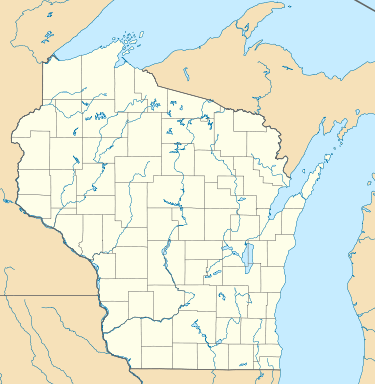General Francis H. West House
|
Gen. Francis H. West House | |
|
| |
  | |
| Location | 1410 17th Avenue Monroe, Wisconsin |
|---|---|
| Coordinates | 42°35′53″N 89°38′15″W / 42.59806°N 89.63750°WCoordinates: 42°35′53″N 89°38′15″W / 42.59806°N 89.63750°W |
| Built | 1860 |
| Architect | Francis G. West |
| Architectural style | Octagon Mode |
| NRHP reference # | 75000066[1] |
| Added to NRHP | January 1, 1975 |
The General Francis H. West House is an octagon house built in 1860 in Monroe, Wisconsin.[2] It was listed on the National Register of Historic Places in 1975 for its association with the historically significant West, and for its unusual combination of multiple polygons.[3][1]
Francis H. West was a New Englander who came west to become an early settler of the Monroe area. He had a diverse career, including lead miner, lumberman, state senator, and California explorer.[3] During the Civil War he commanded the 31st Wisconsin Volunteer Infantry Regiment.[2] In the 1850s, West built a wooden octagon house on the same property as the current house, but it was torn down in the 1930s.[3]
West built the current octagon house from 1860 to 1861, with walls of brick two stories high. Most octagon houses are a single octagon, but this one is three joined polygons, with a rectangular wing behind and a small octagonal cupola on top of them all. The styling outside is Italianate,[3] with brackets and knob pendants under the eaves.[2]
Inside, the first floor contains a foyer, a parlor, a study, and a dining room, with the rectangular wing containing a kitchen, a family room, and a patio. Some of these rooms have parquet floors. The second floor holds bedrooms and a bathroom, with a library in the rectangular wing. From the start, West's house included a progressive-for-the-time gravity plumbing system fed by a tank in the attic, and an "air conditioning" system which let air funnel from the cupola above into the rooms below.[3]
Orson Fowler of New York was the proponent of octagon houses, publishing a book on them in 1847. It's unclear how much Francis West was influenced by Fowler, but West's combination of polygons is unique in Wisconsin and not an idea from Fowler.[3]
References
- 1 2 National Park Service (2008-04-15). "National Register Information System". National Register of Historic Places. National Park Service.
- 1 2 3 "Gen. Francis H. West House". Wisconsin Historical Society. Retrieved 2017-09-04.
- 1 2 3 4 5 6 Biruta Erdmann; Edmund C. Hamilton; Donald N. Anderson (1975-07-15). "NRHP Inventory/Nomination: West, General Francis H., House". National Park Service. Retrieved 2017-09-04. With one photo.